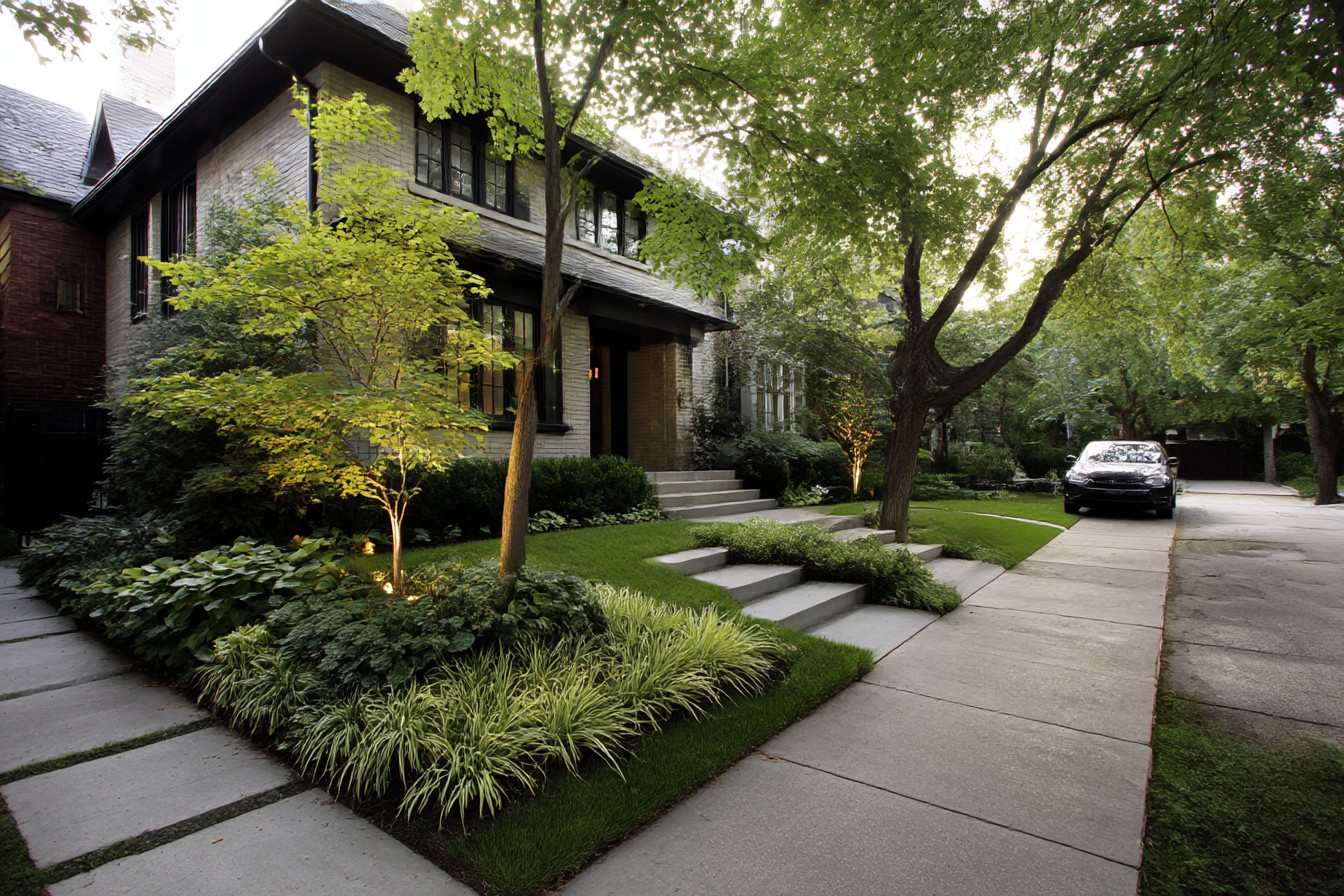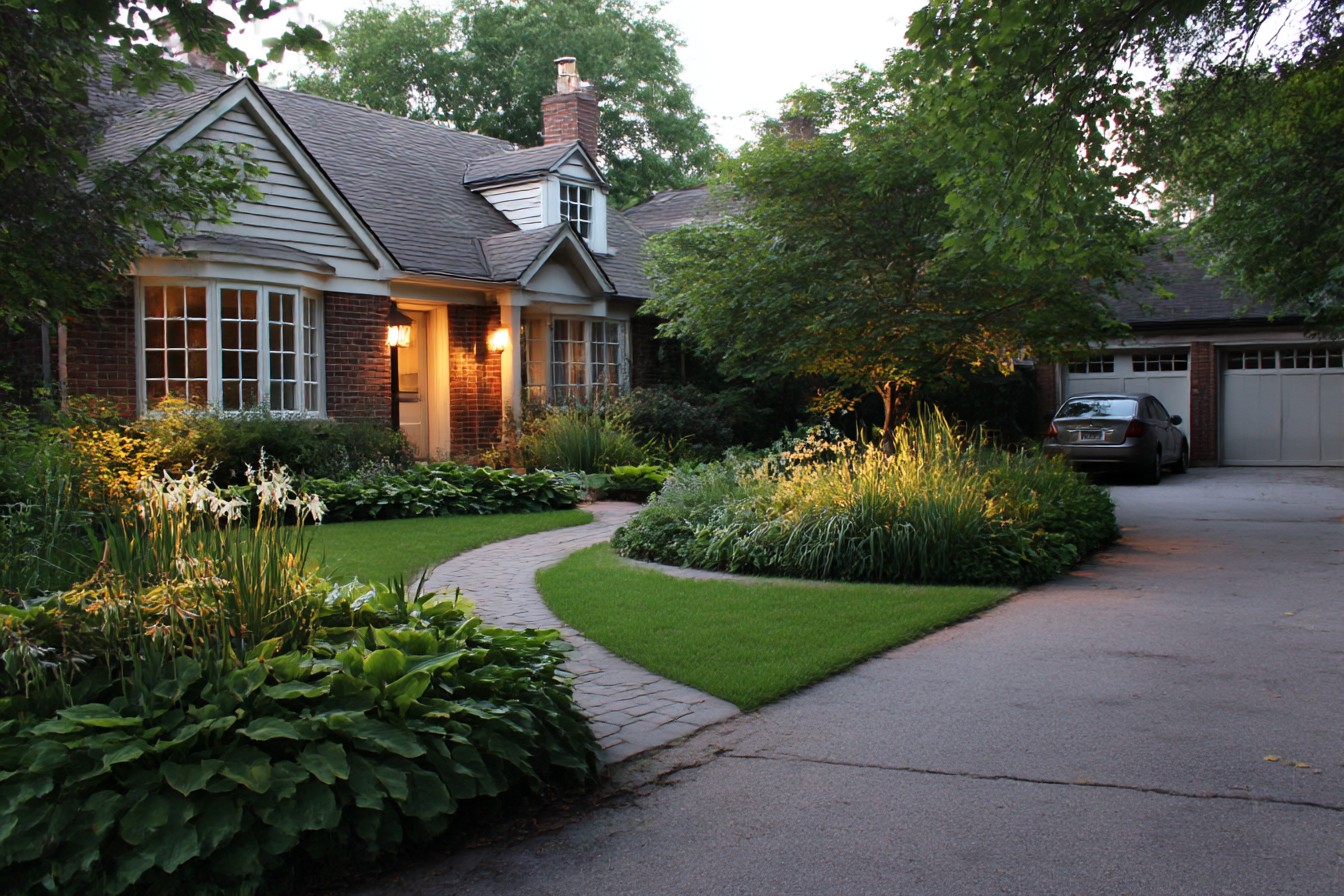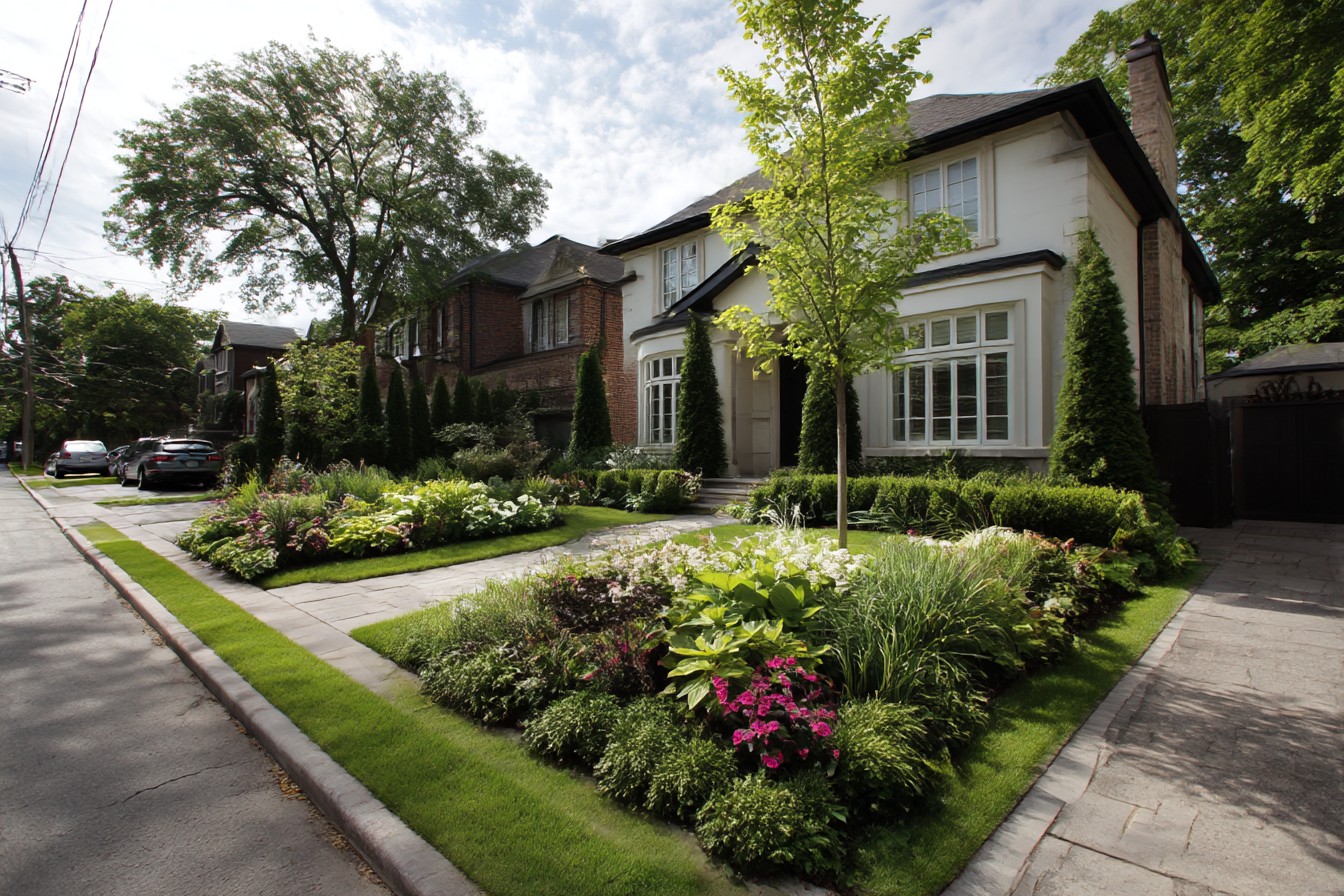I still remember the moment I realized how much a front yard matters. It was after a particularly grueling day consulting on a problem-plagued renovation in St. Paul—the kind where you discover three layers of previous bad decisions every time you open up a wall. I’d spent nine hours crawling through a cramped attic tracing wiring that made absolutely no sense, and my back was screaming. As I pulled into our driveway at dusk, the landscape lighting we’d installed the previous weekend clicked on, illuminating the stone path and highlighting the Japanese maple we’d splurged on for our anniversary. Something in my chest literally loosened. Home. Safe harbor. I actually sat in the car for a minute just looking at our front yard, feeling the day’s tension drain away.
That’s when it clicked for me—curb appeal isn’t just about resale value or impressing the neighbors. It’s about creating a genuine sense of arrival that affects you emotionally every single day. Since that realization, I’ve approached front yard projects completely differently, focusing less on the decorative aspects and more on creating what I now call “the exhale moment”—that transition from public life to private sanctuary that actually changes how you feel.
This perspective shift came in handy when my sister Eliza called about her Michigan home’s front yard issues. “The realtor said we should paint the door red and put out some potted plants before we list it,” she explained, clearly unconvinced. When I visited, I understood her hesitation immediately. The problem wasn’t the door color—it was that arriving at her home felt like navigating an obstacle course. The concrete path had heaved about 3 inches in one spot (classic freeze-thaw cycle damage in Michigan), creating a literal trip hazard. Overgrown yews obscured half the walkway, forcing visitors to turn sideways to reach the steps. The sole light fixture cast sickly yellow illumination that somehow managed to be simultaneously too dim to be functional and positioned perfectly to blind you as you fumbled for keys.

“Forget the red door,” I told her. “Let’s make your front yard actually work first.” We spent that weekend tackling the functional issues—resetting the worst concrete sections, hard-pruning the yews, and installing path lighting that illuminated the walkway instead of the night sky. When we were done, I had her drive around the block and approach her house as a visitor would. “Oh,” she said quietly as she reached the front steps. “It feels…welcoming now.”
That’s exactly what good front yard design should accomplish—a sense of welcome, orientation, and ease. Unfortunately, in many American neighborhoods, front yards have become purely decorative afterthoughts or, worse, status symbols disconnected from how people actually use their homes. We’ve all seen those formal landscapes where the owners clearly never set foot in their own front yards, with ceremonial paths that bypass the driveway where everyone actually enters.
In my experience renovating homes across different regions, the most successful front yards share certain characteristics regardless of architectural style or climate zone. They provide clear, comfortable navigation from public spaces (sidewalk, street) to private territory. They offer visual cues that guide visitors toward the entrance you actually use. They create appropriate transitions that help regulate privacy and exposure. And perhaps most importantly, they reflect something genuine about the home’s occupants rather than rigidly adhering to neighborhood conventions.
Take my neighbor Deb’s 1940s Cape Cod in Minneapolis. When she purchased it, the front yard was a testament to minimalist maintenance—a rectangle of grass, three overgrown arborvitae crowding the foundation, and a straight concrete path from sidewalk to door that nobody ever used because everyone entered through the driveway. After watching her grocery-laden family members regularly perform an awkward sideways shuffle between parked cars to reach the side entrance, I suggested a landscape reset focused on actual traffic patterns.
We removed the unused front walkway entirely, extending her garden beds instead. We created a proper path—wide enough for two people walking side-by-side—from the driveway to the side door, using permeable pavers that handled Minnesota’s freeze-thaw cycles better than concrete. Solar lights marked the route for evening arrivals. Near the entrance, we built a simple bench with underneath storage for shoes, sports equipment, and the seasonal debris that previously cluttered her entryway. The transformation wasn’t just aesthetic; it fundamentally changed how her family experienced arriving home.

The most dramatic front yard transformation I’ve witnessed was for a client in Portland with mobility issues. His 1920s bungalow had the typical high porch stairs that look charming but become genuinely hazardous for anyone with knee problems or balance concerns. Rather than install an institutional-looking ramp (which would have required switchbacks to meet ADA slope requirements), we reimagined the entire approach. We created a gently sloping path that curved through the front garden, disguising the grade change with strategic plantings and stone retaining walls that doubled as seating. The result provided safe access while actually enhancing the home’s craftsman aesthetic. “I used to dread coming home after grocery shopping,” he told me months later. “Now I actually enjoy the journey from car to door.”
Lighting is perhaps the most overlooked element of front yard functionality, especially in older neighborhoods where original homes weren’t designed with modern safety considerations in mind. A client in Chicago had a gorgeous Victorian with an impressively dark approach that had family members regularly using phone flashlights to find the front steps. The issue wasn’t just missing fixtures; it was thoughtful illumination. We installed layered lighting that served different purposes—path lights to mark the route, gentle uplighting on key landscape elements for orientation, and properly positioned porch lights that illuminated the steps and lock without creating glare.
The change in his family’s evening routine was immediate and profound. His kids stopped dreading taking the dog out after sunset. Holiday gatherings no longer involved guests nervously navigating darkness. And there was an unexpected benefit—the defined pools of light made the front yard feel larger and more established. “It’s like we gained an extra room,” he commented during a follow-up visit. That’s exactly right—good landscape design expands your functional living space beyond your home’s walls.
Regional considerations dramatically impact front yard functionality across America. Working on a project in Phoenix taught me how significantly climate shapes arrival experiences. The homeowners had transplanted from Seattle and created a front yard that looked fantastic in photos but was miserable to use for nine months of the year—no shade, reflective hardscaping that amplified heat, and plant choices that offered zero relief from the desert sun. We redesigned with climate adaptation in mind, creating a shade corridor with appropriately drought-tolerant trees, switching to thermal-resistant pavers in a lighter color, and installing a small transitional seating area protected by a pergola. The temperature difference between their original landscape and the revised version measured nearly 15 degrees on summer afternoons.
Snow management is another regional factor that dramatically impacts daily life but rarely appears in design magazines. For a family in Buffalo dealing with legendary lake-effect snow, we completely reimagined their front approach to accommodate winter realities. We replaced narrow, easily buried walkways with broader paths that could be quickly cleared with a snowblower. We selected planting locations specifically to prevent snowdrift formation near the entrance and created a covered transition space where family members could shed snowy outer layers before entering the home. These practical considerations didn’t diminish the landscape’s beauty during snow-free months but made winter arrivals infinitely more manageable.

Maintenance requirements should genuinely influence front yard design decisions. I’ve seen too many homeowners invest in elaborate landscapes that look spectacular for exactly one season before exceeding their capacity to maintain. A teacher in St. Louis loved the idea of an English cottage garden but couldn’t reconcile the maintenance demands with her actual schedule. We developed what she now calls her “lazy person’s showstopper garden”—carefully selected native plants with staggered blooming periods that require minimal intervention but provide three seasons of color. Strategic hardscaping reduced the maintenance footprint further while expanding usability. Four years later, she spends enjoyable time in her garden rather than being perpetually behind on garden chores.
Storage integration is another practical consideration that dramatically improves daily life. For a family in Ann Arbor with active kids, we built what appeared to be a decorative gate with an attached bench at the junction of their front walkway and driveway. The bench concealed waterproof storage for sports equipment, dog walking supplies, and gardening tools. This simple addition eliminated the daily scramble for soccer cleats and kept muddy items from migrating inside. Sometimes the smallest functional improvements deliver the greatest quality-of-life benefits.
Water management—unglamorous but essential—fundamentally impacts how welcoming a front yard feels during inclement weather. For a Seattle client whose original landscape channeled rainwater directly onto the front path, creating perpetually soggy conditions, we redesigned with subtle grading changes and permeable materials. The result was a front approach that remained pleasant even during the rainiest months, with rainwater appropriately directed into rain gardens rather than pooling at the entrance. No more soggy shoes in the entryway or treacherous icy patches during winter freezes.
Of course, aesthetics still matter in front yard design. But I’ve found that when functionality leads, beauty often follows naturally. For a Minneapolis couple who entertained frequently, we created a front yard social space—a slight departure from neighborhood norms but one that reflected their actual lifestyle. A small patio with comfortable seating, positioned to enable conversation with passing neighbors without forcing interaction, became their favorite warm-weather spot. Plantings provided privacy without creating fortress-like isolation. The resulting landscape honestly reflected their sociable nature while significantly expanding their usable living space.
Scale and proportion issues plague many American front yards, particularly in developments where builders applied identical landscape templates regardless of home size or lot configuration. A client in a Nashville subdivision had the standard-issue builder package—three foundation shrubs, two sad trees placed at arbitrary intervals, and a too-narrow concrete path. Everything felt undersized and disconnected from the home’s architecture. We developed a landscape that properly framed the house with appropriately scaled plantings and a walkway whose width actually accommodated two people walking together. The transformation made the modest home feel more substantial and intentionally designed.
The most successful front yards create meaningful transitions between public and private realms. For a corner lot in Denver with problematic exposure, we developed a graduated privacy approach using layered plantings of increasing height. The landscape remained neighborly and open while creating progressively more sheltered zones as one approached the home. The owners no longer felt like they were living in a fishbowl but maintained the community connection they valued.
If there’s one universal truth I’ve discovered about front yards, it’s that they should reflect something authentic about the people who actually live in the home. Cookie-cutter approaches rarely create that genuine sense of arrival that transforms daily transitions. Your front yard should feel like returning to your own space, not maintaining a generic public presentation that could belong to anyone.
So before you paint that front door or plant those foundation shrubs, spend some time honestly observing how you and your family actually use the space. Where do you naturally enter? Where do transitions feel awkward? What regional weather conditions most impact your comfort? The answers will guide you toward improvements that enhance daily life rather than just property photographs. Because ultimately, the best landscape design doesn’t just impress visitors—it genuinely improves the experience of coming home for the people who matter most.